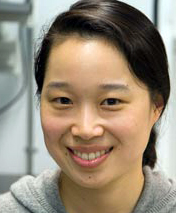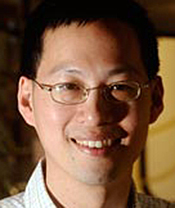Berkeleyan
Four young scientists touted as top innovators
National magazines declare two chemists and two astronomers from Berkeley to be outstanding in their fields
![]()
| 27 August 2008
Four young Berkeley faculty members have been singled out by national magazines as up-and-coming scientists to watch.
Two married assistant professors of chemistry — Michelle Chang and Chris Chang — were among 35 young researchers named this month by the magazine Technology Review as 2008’s top young innovators under 35.
And two young astronomers — assistant professor Joshua Bloom and associate professor Eliot Quataert — were included among Astronomy magazine’s 10 “rising stars.”
The Changs are involved in entirely different areas of research, but Technology Review judged each of them to be people who are “changing our world,” according to an article in the magazine’s September/October 2008 issue (www.technologyreview.com/TR35).
And in its August 2008 issue, Astronomy magazine called Bloom, Quataert, and the others “brilliant people” whose names will surely appear again in the pages of the magazine.
Lignin-chewing, molecule-tagging
The Changs moved to Berkeley about four years ago after obtaining their Ph.D. degrees from the Massachusetts Institute of Technology. Chris Chang was appointed an assistant professor in 2004, while Michelle Chang was a postdoctoral fellow in the laboratory of chemical-engineering professor Jay Keasling before being appointed an assistant professor of chemistry in 2007.
 Michelle Chang |
Michelle Chang, 31, works in the field of synthetic biology, where she re-engineers the metabolism of microbes to make them produce biofuels. With some funding from the new Energy Biosciences Institute, Chang is hoping to create microbes that break down lignin, a tough polymer abundant in agricultural waste, so it can be fermented into biofuel. This work involves research in fundamental biochemistry to understand how some microbes use enzymes to break down lignocellulose, and then metabolic engineering to insert these enzymatic pathways into easily grown microbes, such as the bacteria E. coli.
Because the tools of synthetic biology can be employed to make microbes carry out a range of chemical reactions they normally don’t do naturally, Chang also is trying to engineer bacteria to perform chemical tasks that are difficult, expensive, or dangerous when done industrially. Among her efforts is one to incorporate fluorine into organic molecules, a step required to make some drugs, such as Lipitor, active.
 Chris Chang |
Chris Chang, 33, focuses on finding ways to track the movement of molecules, primarily vitamins and minerals, as they move through the brain. By developing new molecular tags that fluoresce when they react with other molecules, he hopes to track how chemicals move in normal brains versus brains with degenerative disease.
One of Chang’s tags glows green when it reacts with hydrogen peroxide, a chemical found throughout the brain, where its function is largely unknown. The brighter the color, the more hydrogen peroxide a cell is taking up. Chang has used this tag to study neurons from the hippocampus, a brain area vital for learning and memory. His research shows that the chemical, known mostly for causing cell damage, also plays an important role in neural signaling.
Earlier this year, Chang was named a Howard Hughes Medical Institute Investigator.
Infrared transients, black-hole horizons
 Joshua Bloom |
Joshua Bloom, 34, has for years been studying the diverse phenomena of fiercely energetic explosions called gamma-ray bursts. In 2005, the year he joined the Berkeley faculty, he led the team that pinpointed the source of an especially short gamma-ray burst to an old, red galaxy. This clue led him to surmise that the probable cause of short bursts was the annihilation of two neutron stars, a very different event than what was thought to make most other gamma-ray bursts.
As the principal investigator of the world’s largest robotic infrared telescope, PAIRITEL, his interests in other time-variable events (“transients”) has grown. With students and collaborators, he has now published work on results ranging from a unique search for planets orbiting cold stars to new measurements of the expansion rate of the universe using supernovae. He is currently leading an ambitious new development project, the Synoptic All-Sky Infrared Imaging (SASIR) survey, which would search for transients in the infrared sky to unprecedented depths. The project is being conducted in collaboration with the University of California and the professional research astronomy community in Mexico. “SASIR will impact just about every aspect of astrophysics, and hopefully lead to some unexpected surprises,” Bloom says.
 Eliot Quataert |
Eliot Quataert, 34 and director of the campus’s Theoretical Astrophysics Center, was called a “cosmic browser” by Astronomy magazine. A theoretician who came to Berkeley in 2001, he focuses on the formation of supermassive black holes at the centers of galaxies and of the gas falling into the black-hole core. At question is how gas gives rise to radiation near a black hole’s event horizon, a point beyond which nothing, not even light, can escape.
One of Quataert’s ideas explains why supermassive black holes commonly have almost exactly one-thousandth the mass of their host galaxies. At that threshold mass, Quataert says, the black holes grow so large that their powerful radiation prevents fresh matter from accreting.

